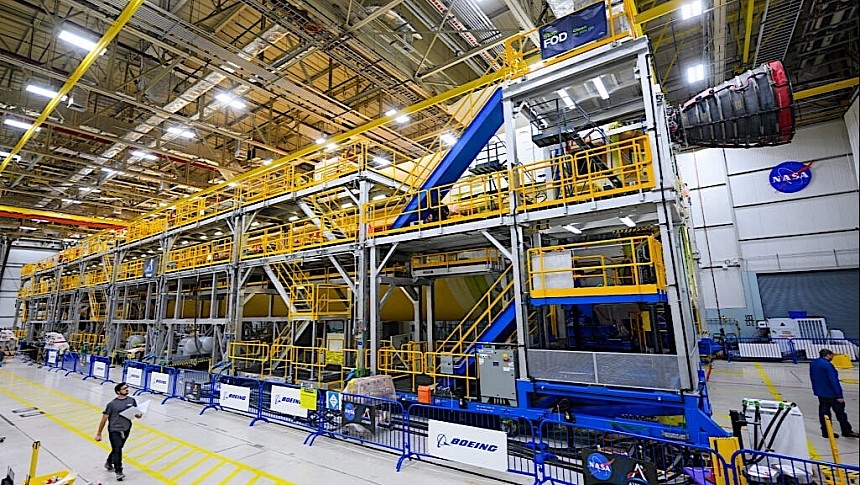We're all for reusing and repurposing objects and materials instead of simply throwing the stuff away, but what NASA is doing with the Space Launch System (SLS) rocket is next-level recycling.
The SLS is the rocket that will enable the return of human beings to the surface of the Moon. It already flew a dry mission and sent the Orion capsule with no crew on board around the Moon, and it is now getting ready to launch four people on a similar journey.
Both in the missions that was and in the ones to come the SLS relies on a core stage and two five-segment boosters to get going. The core stage is powered by four engines called RS-25. Those would be the engines previously developed for the Space Shuttle. And some of them have even been used on Shuttle flights.
This week NASA announced the fitting of the first of four RS-25 engines on the SLS core stage for the Artemis II mission. It's an engine that was previously used on the space shuttle, repurposed for use in this application.
For Artemis II NASA will go for a combination of used and new RS-25s. Aside from the powerplant already installed earlier this week, another engine is Shuttle-used as well. In fact, this second one is the veteran of them all, having flown no less than 15 missions. The remaining two engines are brand new, according to NASA.
The assembly process that will see the rocket getting its engines is taking place at the Michoud Assembly Facility in New Orleans. It's a collaborative effort between NASA, Aerojet Rocketdyne, L3Harris, and Boeing and it also includes installing the structure's electrical systems.
Artemis II is tentatively scheduled to depart in November 2024, carrying a crew of four, including the first person of color and the first woman, on a trip around the Moon. The four are Reid Wiseman, Victor Glover, Christina Hammock Koch, and Jeremy Hansen.
These brave souls will be strapped to a rocket capable of generating 8.8 million pounds of thrust. The RS-25s on the core stage will burn during launch for eight minutes, eating up 1,500 gallons (over 5,600 liters) of fuel every second in a bid to defeat Earth's atmosphere.
Once that is out of the way, the Artemis II mission will have the Orion capsule move on with its trip around the Moon, taking its crew to the farthest distance from our world a human has ever traveled: 6,400 miles (10,300 km) beyond the Moon, and 230,000 miles (370,000 km) away from home.
The mission is scheduled to last for about ten days, and it's meant to validate systems and procedures for Artemis III, the mission that will actually land humans on the Moon.
Both in the missions that was and in the ones to come the SLS relies on a core stage and two five-segment boosters to get going. The core stage is powered by four engines called RS-25. Those would be the engines previously developed for the Space Shuttle. And some of them have even been used on Shuttle flights.
This week NASA announced the fitting of the first of four RS-25 engines on the SLS core stage for the Artemis II mission. It's an engine that was previously used on the space shuttle, repurposed for use in this application.
For Artemis II NASA will go for a combination of used and new RS-25s. Aside from the powerplant already installed earlier this week, another engine is Shuttle-used as well. In fact, this second one is the veteran of them all, having flown no less than 15 missions. The remaining two engines are brand new, according to NASA.
The assembly process that will see the rocket getting its engines is taking place at the Michoud Assembly Facility in New Orleans. It's a collaborative effort between NASA, Aerojet Rocketdyne, L3Harris, and Boeing and it also includes installing the structure's electrical systems.
Artemis II is tentatively scheduled to depart in November 2024, carrying a crew of four, including the first person of color and the first woman, on a trip around the Moon. The four are Reid Wiseman, Victor Glover, Christina Hammock Koch, and Jeremy Hansen.
These brave souls will be strapped to a rocket capable of generating 8.8 million pounds of thrust. The RS-25s on the core stage will burn during launch for eight minutes, eating up 1,500 gallons (over 5,600 liters) of fuel every second in a bid to defeat Earth's atmosphere.
Once that is out of the way, the Artemis II mission will have the Orion capsule move on with its trip around the Moon, taking its crew to the farthest distance from our world a human has ever traveled: 6,400 miles (10,300 km) beyond the Moon, and 230,000 miles (370,000 km) away from home.
The mission is scheduled to last for about ten days, and it's meant to validate systems and procedures for Artemis III, the mission that will actually land humans on the Moon.









